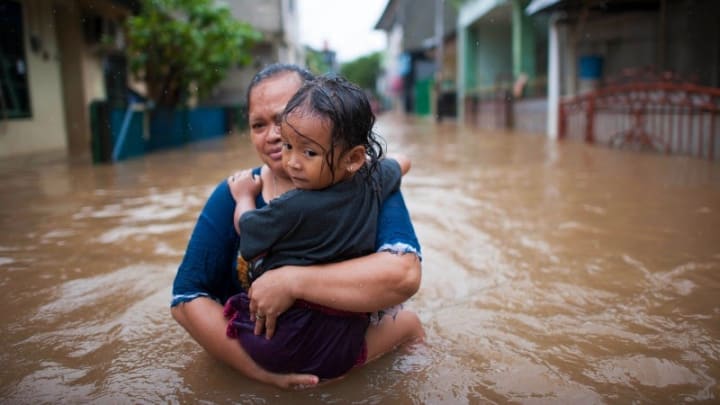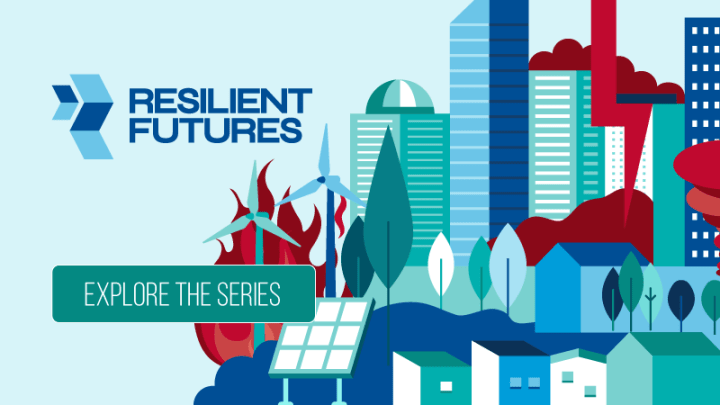
OAKLAND, Calif. — 2020 has been a record year for flooding in the Asia-Pacific region, with cities in East, Southeast, and South Asia seeing economic losses, loss of life, and widespread displacement due to heavy rains.
The figures are staggering — in China alone, 2.7 million were evacuated and 63 million were affected, while Nepal has experienced 4,500 landslides, and, at one point, one-third of Bangladesh was underwater. Another 17 million were affected by flooding in South Asia. Floods also impacted parts of Indonesia, and in the past month, Vietnam and the Philippines have also been hit. Altogether, they highlight the need to scale up solutions to help fast-growing cities build flood resilience.
“Low-lying developing countries and cities in Asia are facing a 1-2-3 punch,” said Sally Yozell, director of the Environmental Security Program at The Stimson Center, a Washington D.C., based research center. “Massive storms, flooding, sea level rise, all on top of the social and economic issues that many coastal communities have — it’s extreme.”
While there is a growing awareness that nature-based and community solutions are needed to increase flood resilience in the most vulnerable cities, scaling up and redirecting climate and adaptation finance remains a challenge across the region.
“Low-lying developing countries and cities in Asia are facing a 1-2-3 punch.”
— Sally Yozell, director of the Environmental Security Program, The Stimson CenterScience points to climate link
Climate change models predict that, in Asia, rainfall during the wet season will become more concentrated while the dry season becomes longer.
Lessons from Haiti: How to build safer cities
Haiti's 2010 earthquake demonstrated just how vulnerable its cities are and why aid organizations can’t rely on standardized approaches.
“We are talking about some 15 to 20% more intense events in terms of the accumulated rainfall,” said Giriraj Amarnath, research group leader for the water risks and disasters program at the International Water Management Institute, based in Colombo, Sri Lanka. “It’s also estimated that these kinds of events are three times more likely, now, due to climate change.”
Flooding alone is not an issue. It can provide benefits for agricultural and fishing production around and near cities. But climate change has made regular seasonal patterns less predictable, straining the capacity of landscapes and urban infrastructure to adapt.
While science has gotten better at connecting specific extreme weather events to climate change, for now, it's too soon to estimate just how much worse, or intense, this year’s floods were due to climate change. One thing is clear, though — climate change will likely mean that these kinds of extreme flooding events will become more common in Asia.
“The impact we have seen across parts of Asia this year fits very much with the trends we have been seeing for many years,” said Matthew Cochrane, spokesperson at the International Federation of Red Cross and Red Crescent Societies. “Today, climate and weather-related events account for nearly 9 out of all 10 disasters.”
Human impacts and solutions
When it comes to flooding, Asia, due to the presence of large populations in vulnerable, coastal cities, and growing urbanization, is the continent of most concern.
A study published in “Nature Communications” last year estimated that 300 million people live in places where climate-triggered flooding will likely occur by 2050, with most of the vulnerable population found in China, India, Bangladesh, and Vietnam. Another study published this past July in Nature’s “Scientific Reports” found that the majority of the high-risk population globally in the next 80 years will be in Asia, especially in growing coastal cities such as Shanghai, China with 27 million, Bangkok, Thailand with 8 million, and Kolkata, India with 14 million.
“When people migrate in Asia, they're more likely to end up staying in parts of the city that are not planned, areas that also tend to get flooded,” said Soumya Balasubramanya, research group leader for economics at IWMI. “More people moving to the cities essentially means more people who are vulnerable to these sorts of disasters.”
While floods make headlines, even smaller changes in precipitation patterns have real social and economic impacts. Bangladesh is ranked high on lists of countries that will be most adversely impacted by climate change, due to its large population residing in low-lying, coastal, or delta regions. There, Kaiser Rejve with the humanitarian organization CARE Bangladesh has seen these changes yearly.
“When people migrate in Asia, they're more likely to end up staying in parts of the city that are not planned, areas that also tend to get flooded.”
— Soumya Balasubramanya, research group leader for economics at IWMI“The frequency of floods [since 1998] has increased with floods now starting earlier in the year and also later in the year, damaging agricultural pursuits and negatively affecting food security and livelihood,” Rejve said. Of the 28 districts impacted were the cities of Sirajganj, Tangail, and suburbs of the capital, Dhaka.
Get development's most important headlines in your inbox every day.
Thanks for subscribing!
Bangladesh is also a major recipient of aid aimed at both increasing resilience to floods and preparing for future climate-related disasters. There is growing awareness that traditional big project solutions, including building sea walls, are not enough.
That is why, in 2019, The World Bank and the World Resources Institute released a report calling for a shift from a focus on gray infrastructure — sea walls, but also dams and traditional wastewater management systems — toward greater integration with green infrastructure and nature-based solutions, which they argue can, together, better flood resilience and water security. These include measures like mangrove and wetlands restoration, absorbent urban surfaces, and building sponge cities that absorb water.
Another challenge is getting actionable data into decision-makers’ hands. Climate-related flood risk is especially challenging as it often requires integration between various government ministries and international actors. That is why, in June, The Stimson Center released its climate and ocean risk vulnerability index, or CORVI, tool.
“CORVI is a planning tool,” Yozell said. “If you focus on just one focal area — sea level rise, or drought, or heat — but don’t look at them all collectively, you’re missing the forest for the trees.”
CORVI hopes to help cities avoid scenarios, like that took place in Jakarta in 2015, when the Ciliwung river flooded. The capital of Indonesia, and a megacity with approximately 10 million residents in the city and around 34 million in the Greater Jakarta area as of 2018, has been subject to increasingly severe floods due to over-development and groundwater discharge, and embarked on a plan to restore river flow within the city.
“The Ciliwung river flow was deemed essential to mitigating flooding in the short term, so thousands of households were displaced,” said Gavin Shatkin, a professor at Northeastern University, who researches flood resilience in Indonesia.
The displaced were from low-income communities, and the resulting backlash led to several court cases, and played a role in the Jakarta governor being voted out in 2017, showing the risk of ignoring socioeconomic factors when designing flood resilience programs. Jakarta is also sinking, so to help alleviate the problem, along with several related urbanization issues, the government is relocating the functions of government to a new capital city on the island of Borneo, a plan now on hold due to COVID-19. Jakarta will still be the financial and business center of Indonesia.
Financing resilience
A report released by the Flood Resilience Alliance in July 2020 found that adaptation funding was falling far short of promises, and that climate-vulnerable countries weren’t receiving preferential treatment from donors.
Balasubramanya believes that the millions who saw their homes destroyed and livelihoods damaged during 2020’s historic floods is a wake-up call to the global community to do something now to quickly scale and fund flood resilience.
“A disproportionate share of money, including public and private financing, has gone to the infrastructure side,” Balasubramanya said. She said she would like to see the process for low-income countries to access development aid for flood risk prevention to be made much simpler and faster. Flexibility is also key.
“The development of human capacity is going to require significant investments in increasing the capacities and capabilities of local populations to participate in things like early warning systems, climate-smart agriculture, and restoring wetlands.”
Visit the resilientfutures.devex.com series for more coverage on the practical ways cities can build resilience and reduce disaster impact. You can join the conversation using the hashtag #ResilientCities.

Printing articles to share with others is a breach of our terms and conditions and copyright policy. Please use the sharing options on the left side of the article. Devex Pro subscribers may share up to 10 articles per month using the Pro share tool ( ).
"asia" - Google News
December 10, 2020 at 09:48PM
https://ift.tt/3qNa9So
Sink or swim? An historic year of floods in Asia - Devex
"asia" - Google News
https://ift.tt/2YpEquI
https://ift.tt/2WkdbyX
Bagikan Berita Ini














0 Response to "Sink or swim? An historic year of floods in Asia - Devex"
Post a Comment